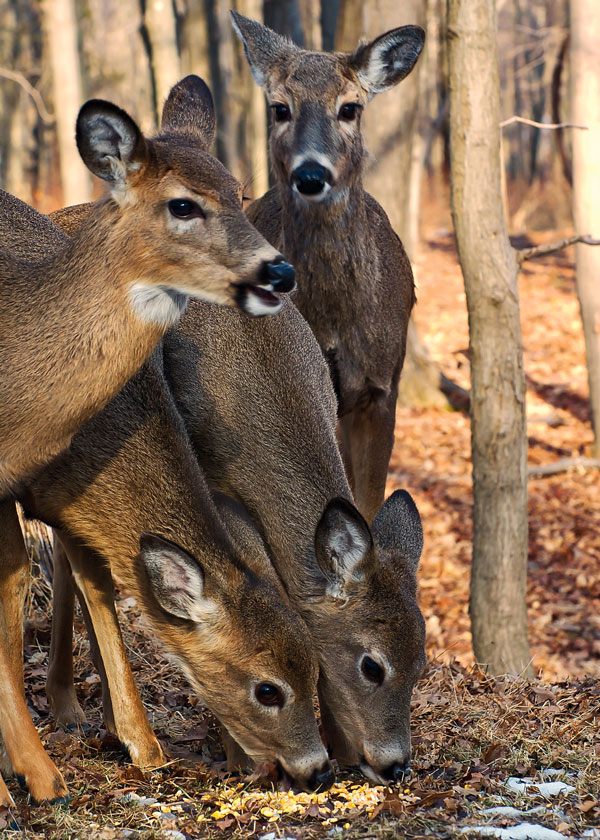They arrive on the earthen dam, the well-nourished female the first to climb up the ravine, nose in the air, white tail up until she feels safe enough to saunter toward the pond that remains at its summertime low. She takes a few sips, her ears twitching, hindquarters quivering from the flies and mosquitoes that will continue to plague her until the first hard frost. Our neighbors have named her The Moocher because of the big doe’s habit of striding toward people, hoping for a handout. She has been known to take a slice of apple from an outstretched palm or nibble on cracked corn out of a bucket. This is as the result of our neighbors’ efforts to feed deer throughout the winter and their continued efforts during the spring, summer and into the fall.

Although only seven-fifteen in the evening, long shadows are already stretching across the little pond that is located alongside the woodlot behind our home. Although each day of summer ends sooner than the previous one, it seems more pronounced as autumn approaches, the change of season much more apparent when daylight saving time comes to an end in another five weeks.
First one and then the other of this year’s fawns follow their mother onto the dam, striding with confidence built up over the four months since their birth. We first noticed one of these scamps lying in Trish’s flower garden in amongst the iris and day lilies. At first we mistaked the white spots on its tawny coat for dappled sunlight, but something seemed off and upon closer examination I discovered the little sprite curled in a ball, eyes open, head leaning on one shoulder. Trish and I did not wish to disturb her, the fawn remaining perfectly still as we backed off.
The following afternoon Trish shooed a fawn she found nibbling on the leaves of a prized rose. Not sure if it was the same deer, a few days later we discovered the twins, as we came to call them, dining together on an azalea that was given to us by a friend and has survived for more than thirty years in our back yard.
Over the next few months we watched this season’s offspring accompany The Moocher on her daily rounds, the two reavers becoming more and more independent as the summer progressed. While still only a few weeks old, they appeared unfazed by the intermittent electrical shock that deters their older brethren from passing through the metal strands of a fence that protects the interior five acres of our property from browsing deer. Brazenly standing their ground inside the fence, the two little fawns would sometimes remind us of their mother, advancing in our direction, coming within a few feet before springing this way and that like two jumping jacks, mocking our efforts to preserve the many plants and bushes we have cultivated with care over the years.
A few moments later a second doe, a bit smaller than the first, climbs up through the ravine and onto the dam. The yearling is a familiar sight, seen often by her mother’s side since her birth two seasons past. The Moocher stamps her front hoof, her daughter approaching cautiously. Trotting over to her mother, she begins licking the inside of her ear. As we watch the doe pay her respects to the matriarch, a third fawn crests the hill, zigging and then zagging over to the twins. None of the three have “buttons”, the tiny stubs male fawns develop in their first year, the smaller females racing around the edge of the pond like three banshees blowing through a Connemara graveyard.
Last to appear are two young males, like the adult females, their coats are mottled, the rich chestnut color of summer slowly giving way to dull gray hair that is longer and more hollow providing greater insulation that will keep them warm throughout the winter. We rarely encounter bucks, but have seen these two during the latter part of the summer, appearing almost always together, never far from the two does and their fawns.
About the same size, the antlers of one have formed into a single set of spikes indicating that he may be in his second season while the other has four points that should make him at least a year older. When the one with spikes saunters over to The Moocher, they touch noses.
In early June, after fawns are born, a mother will ignore her yearlings that return in a few weeks, after the fawns have become more independent. Both males and females then come together, the extended family grazing and grooming similar to the one we are watching on the dam.
Like all families this one cannot remain together, the young having to make their way in the world, the old having to struggle to maintain the place they have carved out for themselves. Sometime in November this extended family will once again separate, the males going into rut, competing with other males and perhaps each other before mating, the chances of either surviving hunting season slim. The young female, if pregnant and surviving the long winter will give birth to another generation, the fawns doing the same the following season while hopefully The Moocher will return to lead another generation into the future.